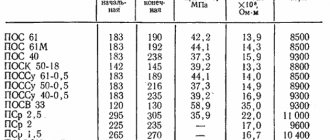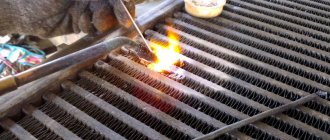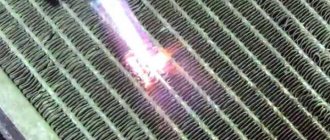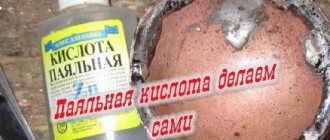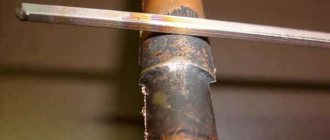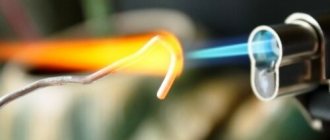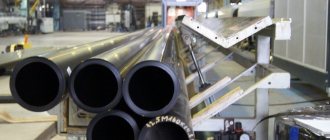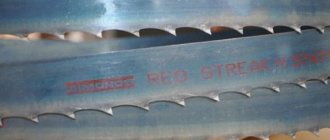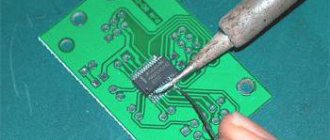Other soldering options: working with copper pipes and various metals
Soldering copper pipes requires some experience in this type of work. Therefore, if a home craftsman takes on such work for the first time, it is worth practicing beforehand so as not to redo a ready-made water supply or heating line several times. Soldering of copper tubes can be done either with hard solder (using a gas torch) or with soft alloys. In the second case, it is appropriate to use a high-power hammer soldering iron for copper pipes.
PHOTO: m-chel.ru Careful and high-quality soldering is the key to the durability of the connection
The nuances of soldering copper pipes: how to do it right
It is best to use rosin as a flux for soldering copper pipes. It is applied in an even layer to the outer surfaces of the pipe, after which the fitting is placed on it. The second part of the line is mounted on its reverse side. Next, the fitting is heated with a gas burner and solder is “laid” along the seams. Under the influence of high temperature it melts, filling the seam and creating a high-quality hermetic connection.
PHOTO: poliasmet.ru Sometimes you have to do without fittings
Soldering copper pipes with your own hands is not too difficult, but this work requires care and precision. Of course, not everything can be explained clearly in words, so we bring to the attention of our dear reader a video on how to solder copper with a gas torch, from which everything will become more clear.
Having dealt with the question of how to solder copper tubes at home, you can move on to the next problem, namely soldering non-identical metals (copper with aluminum, iron or stainless steel).
How to solder copper wire to aluminum
Soldering aluminum and copper is a rather complex process. It should be noted that the same solder is unlikely to be suitable for aluminum as for copper, and vice versa. It is much easier to combine these metals using a steel coupling. Although today the manufacturer offers special solders and fluxes for such purposes, their cost is significant, which makes such work unprofitable.
PHOTO: kak-eto-sdelat.info Soldering copper and aluminum is quite difficult
The whole problem lies in the conflict between copper and aluminum. They have different refractoriness and density. In addition, when interacting with copper, aluminum begins to oxidize strongly. This process is especially accelerated when electric current passes through the connection. Therefore, if it is necessary to connect copper and aluminum wires, it is best to use WAGO self-clamping terminal blocks, which contain Alu Plus contact paste inside. It is this that removes oxide from aluminum, prevents its subsequent appearance and promotes normal contact with copper conductors.
Having figured out how to solder copper to aluminum, you can move on to harder metals.
PHOTO: mastergrad.com Sometimes you can’t do without such a connection
How to solder copper and stainless steel
When soldering copper to stainless steel, it is not the solder material itself that plays a big role, but the tool used, although a lot depends on the consumables. The most acceptable materials in this case are:
- copper-phosphorus solder;
- tin-silver (Castolin 157);
- radio engineering.
Some craftsmen claim that with the right approach to work, even the most common solder based on tin and lead will do. The main thing is the mandatory use of flux (borax, soldering acid), thorough heating and only after this soldering (applying solder).
PHOTO: cusi3.ru Complex soldering of copper and stainless steel
Such connections are rare, and therefore specialized solders for such purposes are quite expensive.
Soldering copper with iron - is it possible?
This option is possible, but subject to certain conditions. For example, a simple propane torch is no longer suitable as a heater. Propane with oxygen must be used. You need to use borax as a flux, but brass will be the solder. Only in this case can we hope for a normal result. It is not difficult to buy solder for soldering copper with iron or stainless steel. The main thing is to understand whether the extra costs will be justified.
PHOTO: svarkavol.ru Soldering copper and iron tubes is also possible
And now we propose to look at how carefully home craftsmen can carry out the work of soldering pipes of mains for various purposes.
What you need for soldering with a soldering iron
In addition to the soldering iron itself, you will need solders, rosin or fluxes; it is advisable to have a stand. While working, you may need a small file and small pliers.
Most often you have to solder copper wires, for example, on headphones, when repairing household appliances, etc.
Rosin and fluxes
To get a good connection between the wires, it is necessary to clean them of contaminants, including oxide film. While mono-cores can still be cleaned manually, multi-core conductors cannot be cleaned properly. They are usually treated with rosin or flux - active substances that dissolve contaminants, including oxide film.
Both rosin and fluxes work well, but fluxes are easier to use - you can dip a brush into the solution and quickly process the wires. You need to put a conductor in rosin, then heat it with a soldering iron so that the molten substance envelops the entire surface of the metal. The disadvantage of using fluxes is that if they remain on the wires (and they do), they gradually corrode the adjacent sheath. To prevent this from happening, all soldering areas must be treated - the remaining flux must be washed off with alcohol.
Solders and fluxes for soldering copper wires with a soldering iron
Rosin is considered a universal remedy, and fluxes can be selected depending on the metal you are going to solder. In the case of wires, this is copper or aluminum. For copper and aluminum wires, use LTI-120 flux or borax. A homemade flux made from rosin and denatured alcohol (1 to 5) works very well, and it’s also easy to make with your own hands. Add rosin to the alcohol (preferably dust or very small pieces of it) and shake until dissolved. Then this composition can be used to treat conductors and strands before soldering.
Solders for soldering copper wires with a soldering iron use POS 60, POS 50 or POS 40 - tin-lead. For aluminum, zinc-based compounds are more suitable. The most common are TsO-12 and P250A (made of tin and zinc), grade A (zinc and tin with the addition of copper), TsA-15 (zinc with aluminum).
Convenient to use solder with rosin
It is very convenient to use solders that contain rosin (POS 61). In this case, there is no need to pre-treat each conductor in rosin separately. But for high-quality soldering, you must have a powerful soldering iron - 80-100 W, which can quickly heat the soldering area to the required temperatures.
Auxiliary materials
In order to properly solder wires with a soldering iron, you also need:
- Stand. It may be completely made of metal or have metal holders for a soldering iron attached to a wooden/plastic stand. It is also convenient if you have a small metal box for rosin.
It’s more convenient to solder with a soldering iron with a homemade or factory-made stand - not very important
This is how you need to sharpen the soldering iron tip
Pliers - to hold the wires
Alcohol may be required to wash off the flux, and electrical tape or heat-shrinkable tubes of various diameters for insulation. These are all the materials and tools without which soldering wires with a soldering iron is impossible.
How to solder copper with hard and soft solder
Copper products are found everywhere in different areas of life. For example, it is used to create strong and durable heating and water supply systems. But to connect the two elements, experts resort to a special technology - soldering copper pipes. The procedure requires suitable tools and materials, as well as knowledge. Since it has certain features that a beginner may not know about.
To solder copper, the master needs to have with him a composition such as solder. This thermoplastic substance seals the surface of the product and, under the influence of high temperature, melts, spreading over the entire joint. But as soon as it cools, it hardens and securely holds the products together.
The result is one item that has a long service life, withstands high loads, pressure and temperature changes, and is not afraid of ultraviolet radiation.
Technology for soldering copper pipes at home: work in 9 simple steps
Plumbing or heating systems made from copper pipes are expensive, but they are strong and durable. Since copper has a high thermal conductivity coefficient, good anti-corrosion and antibacterial properties, pipelines made from it are efficient and durable. Soldering copper at home is not difficult: a socket-coupling is put on the pipes, and then the seam is sealed. Instead of using a flare, sometimes they widen the end of one pipe and insert another into it. This connection is convenient because it does not require fittings, and the service life is equal to the life of the pipes themselves.
What tools and materials are needed
Soldering is carried out not only at industrial facilities, but also at home. To do this, you need to prepare the following tools and materials:
- electric soldering iron or gas burner;
- pipe cutter;
- solder;
- flux;
- brush and steel brush.
How exactly to connect the products depends on the convenience and preference of the master. But the power of the device is selected in accordance with the melting temperature of the solder. Flux can be liquid or solid; each type has individual differences that should be taken into account. If the material is used in the form of a thickened mixture, then it is applied to the joint, both before and after the connection. Flux is needed to protect the surface from oxidation, promote solder flow and improve adhesion.
Preparation for soldering copper with aluminum, brass, stainless steel, iron
The preparatory period, which includes the acquisition of the necessary devices, materials, personal protective equipment, and the soldering procedure itself.
There are two ways to solder copper to copper: high and low temperature. The first involves heating the metal to 900°C, and is used for pipelines with high pressure or temperature load. For high-temperature soldering, materials intended for this are used: hard solder in the form of rods (the melting point of such solder is about 900°C) and hard-melting flux.
In order to solder copper using the low-temperature method, it is sufficient to heat the metal to 600°C (usually 300–380°C), which is achievable in domestic conditions. For the procedure, soft solder is used for soldering copper and brass in the form of a wire or rod with a cross-section of up to 3 mm and a more fusible flux. Solder is an alloy of tin, which is more than 97%, with other metals: copper, selenium, silver, antimony.
- Why do you need flux? Correctly soldering copper pipes can only be done with flux - a special paste-like composition (with zinc chloride), which is applied to the surface of the connected sections of the pipe in a wide strip. It performs several functions:
- prevents the process of metal oxidation by removing oxygen;
- improves the adhesion of solder to copper;
- is an indicator of sufficient heating of the metal, signals when to apply solder and solder the copper;
- promotes uniform spreading of solder along the joint.
- Safety precautions. Despite the simplicity of the process, soldering copper pipes must comply with safety rules. The danger of burns is posed not only by the burner flame itself, but also by the heated metal. Copper conducts heat well, so during operation, not only the area on which solder is placed and welding is carried out, but also the entire pipe becomes very hot, and it cools down slowly. If you need to solder copper tubing that is not already built into the piping system, preparation involves placing it on non-flammable supports where it can take a long time to cool. Before touching the welded metal from its place, you should wait until it cools completely.
The immediate danger is the open flame of the burner, so you need to purchase a tool that is convenient to work with: preferably with a movable nozzle on a long hose
Types of fluxes and solders, features of working with them
Craftsmen know a variety of hard and soft substances that ensure high-quality soldering of metal products. 95% use tin, which is a low-temperature composition with slightly worse technical parameters. But it is valued for the fact that work can be carried out at any temperature without reducing the strength of the products being joined.
Connecting elements also include silver, which has excellent technological properties. Craftsmen often use three-component compositions of silver, tin and copper. Often, materials used in low-temperature soldering contain zinc chloride.
The advantage of soft solders is that they cover a larger area when applied to the surface of the part. They provide high strength and reliability.
Soft solders
Soft solder is used in the installation of water supply and heating networks, where the pipe diameter reaches 10 cm and the water temperature does not exceed 130 degrees. These types include:
- lead-tin type;
- with low tin content;
- special and fusible.
How to choose solder?
The final result of the quality of the work performed largely depends on the choice of a certain type of solder. It ensures complete filling of the treated surface. The most common and affordable method is to use brass solder to solder stainless steel to copper. In some particular situations it can be used even without using flux.
Important: the use of this type of solder is in many ways inferior in physical properties to other methods, however, due to its availability and simplicity, it can be used for soldering simple connections that will not incur a high level of responsibility.
In addition to the above method, you can also use solders from the following materials:
- copper-phosphorus material - it can significantly improve the quality of the final connection, but the cost of this solder is quite high;
- tin-silver material - the use of this type of solder is best suited for joining stainless steel with copper, however, the use of this method is associated with high financial costs;
- To create the simplest connections, you can use ordinary radio consumables, but it is best to choose specialized material.
Why do you need solder paste?
Solder paste is a pasty mass consisting of small particles of solder, flux and special additives. Flux paste is used in industry when soldering elements on printed circuit boards. The paste is selected according to certain conditions:
- after application there should be easily removable particles;
- the substance must maintain viscosity and stickiness;
- do not have a negative impact on the surface being treated;
- do not leak onto clothing during melting.
How to work with the paste depends on the type and size of solder contained in its composition. The material also differs in the type of flux (rosin, water-washable, no-clean). It is necessary to hold small parts in place and facilitate the joining process.
Preparing wires for soldering
Good preparation is half the success
Before soldering, the wires must be properly treated. To do this, just follow the sequence:
- At the junctions of the wire strands, the insulating layer is cut off by 2-5 centimeters.
- Bare areas are cleaned of the oxide film.
- Tinning is carried out, for example, using rosin resin.
- The wires are connected by twisting.
Now you can directly solder.
Soldering technology
The process is quite simple, therefore, when it is necessary to connect something at home, the owner does the soldering with his own hands and without the involvement of specialists. But still, you can’t do without the preparatory stage.
It determines how high-quality and reliable the connection will be. First of all, you should pay attention to the cut of the part, which should be strictly vertical, without burrs, with even and smooth edges. If you find the slightest defects, you should take sandpaper and rub it over the surface until the defects disappear.
If two copper pipes are connected, then, having brought the cut to an ideal state, it is necessary to insert it into the fitting and then remove it. The part that came into contact with the fitting must be cleaned of oxidation. The next step is applying flux. There is nothing complicated about this, you just need to run the brush over the entire part, paying special attention to the joint.
Then the elements are connected to each other and firmly fixed. Further actions depend on what is being used for soldering - a gas torch or a soldering iron. Considering that the parts must be stationary, an assistant will be required. He will be the one to hold them, but if one is not found, you need to manage and do it yourself.
When something needs to be soldered at home, a solid compound is most often used. But the master can purchase special pastes. With the correct choice of compositions, it is possible to connect two pipelines or radio components as accurately and firmly as possible.
Soldering is performed at either high or low temperature. In the first case, the process is distinguished by high strength of the seam, and the connected area also gains heat resistance. Which is very important if it later serves as part of various communications. But high-temperature soldering is not allowed on threaded connections. Most often this process is performed with a propane-filled torch.
When low-temperature soldering is used, a soft compound, paste or gel is used. It is most suitable for a beginner master because it is simple and easy. In this type of process, the temperature does not rise above 425 degrees, so it is even possible to use a soldering iron, which is found in almost every home.
Working with a soldering iron
Every person has seen a soldering iron at least once in their life, and many constantly work with it. Therefore, they will not see anything complicated in soldering copper products with this tool. The whole essence of the process is that the solder located between the two parts is heated with a soldering iron until it begins to melt.
When it hardens, the two parts will be securely fastened into one. To solder efficiently, it is necessary to distribute the substance evenly over the entire surface, filling every gap. It is important to choose exactly the material that can withstand the high temperature of the soldering iron.
Working with the burner
The tool is turned on when the two parts are already connected to each other. You should not hold it near the joint for too long, since the combustion temperature is several thousand degrees. While you only need to heat a certain place to 250-300 degrees.
This will take 20-30 seconds. As soon as the flux changes color to dark, the compound to be joined is introduced. Important! The burner or hair dryer should be placed in the middle to cover the entire joint area.
How to solder copper to iron
Often there is a need to fasten steel parts without drilling and without welding. Soldering steel will help. But how to do it correctly, because there are special nuances here. A few recommendations from experts.
What kind of steel solders well?
Some grades of steel lend themselves well to soldering, while others are soldered with great difficulty and do not want to be combined with any solder or with any flux. As a rule, soft steels "for nails" are easy to solder.
At the everyday level, this can also be explained by the fact that the material is dotted with microscopic craters and irregularities. But there are also electrical grades that are especially hard and elastic, and are used for shafts and precision mechanics.
It depends on your luck here...
The question is that it is impossible for a home craftsman to determine the brand by eye. You can only find out how well a given part made of steel, or an alloy close to it, is soldered by experimentation.
How to make a tin connection - procedure
It all depends on how successfully the part can be tinned and how strong the contact of the tin solder with the steel is. In order for the contact to be satisfactory, if possible at all, the following must be done:
- steel stripping, chemical stripping under solder;
- heating the part to the melting temperature of the solder, keeping the solder on the part under flux for some time in a fluid state.
Cleaning the steel is first done mechanically, using sandpaper, to remove layers of rust and dirt. Then a composition that reacts well with iron oxides is used as a flux.
The most harmless to use, but effective in this case, is orthophosphoric acid, which can be easily purchased at a car store as a “rust cleaner.”
The required power of heating devices depends entirely on the mass of the parts.
The process of soldering two steel parts
If you need to solder two large nails, then the power of one soldering iron 100 W will not be enough.
To heat up a large nail or a similar weight steel part clamped in a vice, you need to use a hair dryer. Or a gas burner.
You will also need cotton wool on a stick to supply flux to the heating zone, and a soldering iron of 50 W or more.
- The sanded steel is heated with a burner.
- Phosphoric acid is applied to the hot part and molten tin solder is immediately applied with a soldering iron.
As a rule, steel parts that can be soldered develop a very strong bond with tin, i.e. When the metal is coated, it is tinned.
The same is repeated with another detail. Then the two parts located together are heated, and additional solder is applied to the contact area with a soldering iron.
How strong is the soldering of steel, can it be made stronger?
The strength of such a connection will be determined by many factors:
- strength of bond between solder and metal,
- connection area,
- direction of the load in relation to the welded planes.
But in any case, the strength of tin soldering cannot be compared with what is commonly understood as the strength characteristic of steel or “metal welding”.
You can strengthen it by using another solder - special strong and more refractory compounds containing silver, zinc, copper, etc.
Another direction for increasing strength is to cover with solder not only the plane, but also the sidewalls of the part - covering the part with solder. Then the pull-off resistance under multidirectional loads will be greater.
Extra strong soldering, special solders
To use compounds that provide a strong connection with steel, with its own melting point of about 800 - 900 degrees, you need to use a graphite crucible.
The work should only be carried out by specialists in metal smelting.
It is necessary to know the basics of metal melting, the procedure for handling melts and safety precautions.
In general, soldering of steel with heavy-duty solders is performed at specialized enterprises.
Possible solder composition:
- 55% zinc, 45% copper, some silicon to increase fluidity.
The composition is melted under a layer of coal in a graphite crucible. Steel parts to be soldered are heated with a gas burner.
Phosphoric acid is used as a flux. The melt is fed to the parts.
As a rule, tinning and soldering are carried out during one heating of both the parts and the solder.
But such soldering of steel is more complex than simple welding...
How to Solder Copper to Metal - Metalworker's Guide
When joining copper products, various tools and equipment are used, without which the soldering process would not be possible. The main tool is a soldering iron. In addition, you can use a gas burner or special ovens.
At home, it is preferable to use soldering of copper products; this option is the simplest and fastest compared to cooking. In addition, you do not need special equipment to carry out the fastening.
If all the rules and conditions of the technological process are observed, a strong and reliable connection of elements can be obtained, increasing resistance to various loads.
To ensure that soldering at home does not cause difficulties, first of all you need to take care of the basic tools that will be involved in this process:
- pipe cutter;
- chamfer;
- pipe expander;
- steel brush;
- steel brush;
- solder;
- burner or hair dryer.
For a tubular device, a method is used when the element is immersed in a composition of salt and solder. Salt acts as a heat source and replaces the functions of flux. Therefore, additional flux is not needed.
In addition to this method, there are several other soldering options that deserve attention.
Soldering copper
Brazing
The most common method of soldering at home is brazing copper.
This is explained by the properties of copper, which melts easily at low temperatures. A soldering iron or gas torch is quite suitable as a tool.
Soldering copper is a bit similar to the welding process, but still has some minor differences:
- When soldering parts, an additional substance, solder, is used, which connects these elements. This is possible due to the properties of solder, which has a low melting point.
- The most common materials for soldering parts are nickel and tin. These are affordable and simple components that are used in most cases. As for industrial use, other types of solder are used for these purposes, but for home use they are quite expensive and, therefore, unprofitable.
- To solder copper products, you must first melt the solder until it reaches the desired consistency in order to apply it to the place where the elements are soldered. After this, you should wait until the connection cools completely.
If all the nuances of the process are carried out exactly, then such a connection will be strong and durable.
Soldering in ovens
Soldering of copper in furnaces is carried out under production conditions. This process ensures uniform heating of the parts, completely eliminating its deformation.
Tin or an alloy of tin and lead is used as an alloy; a composition of rosin and alcohol, or a composition of ammonium chloride or zinc, is used as a flux.
When using solder with a silver base, fluxes are used, which are based on compounds of fluorine, potassium and boron.
These fluxes best clean the bonded surfaces from the oxide film, this will allow the alloy to be perfectly distributed over the entire surface.
Flux Soldering
This procedure has one big disadvantage, it is the implementation of a hermetic bond.
Excess flux creates additional pockets that are subject to corrosion; as a result, soldering is performed in neutral conditions or in a reducing gas environment. To solder in nitrogen, the required temperature must reach 750–800 degrees.
Vacuum soldering
Vacuum furnace for copper soldering
Vacuum soldering is used for many metals, copper is no exception. Copper soldering is carried out in specialized furnaces, or containers, which are then placed in the furnace.
Despite the complex equipment, this option is considered the most effective by all criteria. Bonding of copper products is done with soft solder or pure tin.
You can use other types, for example, silver alloys, using a flux of rosin-alcohol solution.
In order to use cadmium solder, it is necessary to prepare a special tool and stock up on the necessary knowledge in this area, because the manufacturability of this material is much lower than that of tin-lead tinols.
Soldering with silver solder
When you need to solder parts at home, silver solder is often used. It is beneficial because you can create it yourself. But it should not be used alone, in combination with zinc and copper.
Treated with this solder, the seam will be very strong and neat. The percentage of components is controlled by GOST 19746 74. But you can find out exactly what types of substances to use from the instructions of experienced craftsmen or those included with the products being connected.
How to solder copper and stainless steel
If you need to solder copper to another metal, such as steel, you will have to work hard. This process is not easy, but it is quite feasible. This is explained by the fact that stainless steel interacts poorly with other metals and is difficult to heat treat.
When two different products are combined, you need to find an average composition that suits both at the same time. In such cases, you have to sacrifice quality and it is not even necessary to use flux. But it is important to carry out preparation, tinning and other soldering steps.
The need for a connection often arises at home. Joining stainless steel and copper requires little time and a conventional gas torch is sufficient. Therefore, having decided on the tool and solder, you should clean the surface of both joints and prepare flux. Then tinning the bonding area and applying flux. After which the two parts are connected, and the resulting seam is coated with solder.
The next stage is its uniform heating with a burner. Once the solder has spread, the product is left to cool naturally.
Is it possible to solder a fistula in a copper pipe with a soldering iron?
Actually the question has already been formulated. A small hole has appeared in the copper pipe through which cold water flows to the gas water heater. What is the best way to seal it? Is it possible with a soldering iron? What kind of solder and flux? Thank you.
Hmm. Why did this hole form in the copper pipe? Did they break it? The easiest way is to solder a copper patch. Any soft tin-lead solder, or even alcohol-rosin flux, the main thing is to clean it well with sandpaper. You will need a powerful soldering iron, I think two hundred watts, or better yet, a torch.
Yes, no, it doesn’t seem to have punched through. I don't know why. Apparently a manufacturing defect from Vaillant - the tube is already part of the column. Or maybe you can describe the sequence of actions in more detail. I'm not a super expert at soldering. I had to solder, not very much, and always in electronics.
Yes, actually, nothing complicated. We cut out a copper patch (1 cm2 is enough), sanded the pipe and the patch, drained the water from the pipe, heated it with a soldering iron and tinned the pipe and the patch. We applied the patch to the pipe, heated it, added solder. That's it.
Why did this hole form in the copper pipe? Did they break it?
No, it looks like this is still a compatibility problem between copper pipes and St. Petersburg water. Leaks appear the size of a pinprick 2sshura How much does a water heater cost? When I lived in an apartment with a water heater, the domestic heat exchanger failed after 5-6 years. The last time, four years ago, two pinhole leaks appeared, I spat, and since I didn’t have a powerful soldering iron at hand, I covered it with Proxypol (but the pressure in the cold water system is low And subsequent leaks too. It’s more competent to put a patch, as DOKA indicated
you strip and wind the copper wire, and even from the twisted pair (just remove the insulation), wind it tightly turn to turn and apply flux, for example LTI-120 (then it is necessary to rinse) is sold in any radio products, but you can also use the flux used to solder copper pipes, it costs about 100-120 rubles/ It costs 100g to heat, what is the diameter? You may not be able to take a soldering iron, it would be better to apply the solder with a torch, the solder evenly impregnates the turns due to capillary forces
PS to my father-in-law, I soldered the brake pipe like this a long time ago, it got worn out, then he changed it
2Do Home Yourself
This is not possible in all places of the water heater heat exchanger. Yes, and you may need a powerful burner
I’ve had copper in my apartment for nine years, it’s clean and in an Indesit gas water heater and without any problems. There may be a problem at the junction of copper and iron; electrochemical corrosion may occur there, or there may be some potential sitting on the pipes that causes corrosion. Some idiot grounded the washing machine like that. And soldering the hole is elementary.
Thanks for answers.
Yes, you really can’t wind the wire there (one side of the tube is soldered to the heat exchanger). The column lasts a little less than two years. I don’t know about electricity, but I really doubt it. The house is not big. The diameter of the tube cannot be measured exactly now, but it is approximately 12 mm.
I temporarily sealed it in a very barbaric way - filled it with superglue. I understand that cyanoacrylate is poison, but we don’t drink hot water, and there was an urgent need to provide hot water supply. As long as it holds.
But still, if with a soldering iron, then what power might be required? And what kind of solder? Or maybe really Poxipol? Or something else like that? And one more thing: all the heat exchanger tubes there (now except for the place where the fistula) are covered with some kind of silver paint (from oxidation, I think). So when I warm up the pipe, it won’t all bounce off?
I thank all participants.
sshura wrote: But still, if with a soldering iron, then what power might be required? And what kind of solder?
I myself solder radio components, and very rarely such large things. But I can give some tips to make soldering easy and of high quality.
- It is best to remove the tube before the operation - it will be much more convenient. If it is not possible to remove it, be sure to drain all the water. If there is water in the pipe near the soldering point, it will be very difficult to heat it even with a powerful soldering iron.
- Flux: the one used to solder radio components (look for it at your nearest radio market). If you don’t want problems in the future, then take a flux that says “corrosively passive” or “does not require cleaning.”
- Solder: again on the radio market, the brand must be POS-61. All other POS are more refractory, less fluid and have a worse structure. A good choice is solder in the form of a wire, possibly with rosin filling.
- I think the power of the soldering iron is 100 watts, it may have to be heated additionally (burner, gas stove). Clean the tip from old burnt flux.
- It is good to clean the pipe with sandpaper wherever the solder will go. Wipe to remove dust.
Wrap the pipe on both sides of the soldering area with rags (so that it cools less and can be held by hand).
The soldering area must be well tinned:
- Lubricate the soldering area with flux, apply a well-heated soldering iron with a drop of solder. Move the soldering iron, rubbing the solder.
- If the solder under the soldering iron hardens or turns into mush, it means it is cold. Do the following: Warm up the soldering area with a torch or other method.
- Wrap the soldering area with a thick rag, wait until the soldering iron heats up, and try to warm up the solder again. And so on several times. Gradually the pipe will heat up and the solder will spread.
Basic mistakes when soldering yourself
Most often, it is haste that leads to the fact that the connection of two elements is unsuccessful. Because they forget to inspect the surface of the parts being connected. The first action aimed at correcting an error is checking for the absence of defects. They could appear when cutting parts.
How reliable the seam will be depends on the cleanliness of the surface. Therefore, it is still worth brushing off even invisible specks of dust. One of the most basic mistakes is made when applying flux. The master may forget to process a small area of the product. And it will cause the proper connection to fail.
It is also important to monitor the temperature of the torch or soldering iron, since overheating of the element being processed leads to combustion of the flux. But insufficient melting point is also harmful. In this case, the connecting compounds do not soften or stick.
Theory
Copper is one of the oldest metals, which is used by people to create various decorations, devices and communications. It is characterized by high plasticity and pinkish-red color, sometimes with a golden tint. In the household, copper is most often used in water pipes and heating, because it does not corrode and is resistant to temperature changes.
Photo - copper connections
There are many types of soldering; capillary soldering is used for copper. It allows you to connect two parts of a pipeline or radio components as accurately and firmly as possible. This thermal effect is also divided into:
High-temperature soldering is characterized by higher weld strength. In addition, it allows the connection to be thermally stable, which is very important for various communications. But at the same time, this type of work is not used on threaded connections. To carry out such soldering, special equipment is required - a burner with piezo ignition and acetyl, propane.
Photo - copper elements
Low temperature is used when working with soft solders (pastes, gels). The main advantage of this technique is the simplicity and ease of work. It is carried out at a temperature lower than 425 degrees, so soldering can even be done with a soldering iron. It lies in the fact that, under the influence of a certain temperature, the solder applied to the gap between the part and the area being connected expands, closing the gap.
Soldering tools
Before starting work, you need to prepare special tools and devices for soldering copper connections. You will need:
- Gas or oxygen torch for soldering copper (with nitrogen, acetate, etc.);
- Solder (for capillary soldering according to GOST R 52955-2008);
- A brush (hard, but not metal) and abrasive paper for stripping copper connections;
- Fittings or other connected elements;
- Soldering flux.
It should be noted that if the work is done on pipe connections, then you may also need a chamfer, an expander, or a special cutting device. All of these fixtures can be found at a professional plumber so you don't have to buy them.
Photo - burner
Burners for copper are: professional (for working with hard solders), for heating pipes and soldering with soft pastes, semi-professional or combined. There are also special hair dryers that are used for soft soldering. They allow you to quickly heat the joint at temperatures up to 650 degrees.
- Solid. They are represented by rods of a certain diameter, which is selected based on a certain gap when connecting. It is used when connecting copper and iron in water supply systems, gas supply and air conditioning systems. This solder can be with phosphorus or silver;
Photo - hard solder - Soft ones can be either in the form of paste or thin wire up to 3 mm in diameter. They are produced with lead and tin. Also sometimes the process is carried out with orthophosphoric acid.
Also, to join copper alloys, it is necessary to use flux. It performs several useful functions: it promotes better spreading of solder over the metal, protects the processing area from an oxygen film, and cleans the seam from oxide. Fluxes come with borax (for various high-temperature solders), used for medium-melting compounds of gold, copper, bronze, cast iron, and stainless steel. Outwardly, they look like a paste and are applied with a special brush.
Photo - flux paste
Brushes and abrasive sheets (sandpaper) are needed to remove solder residues from the seam after finishing work. Fittings are selected based on the required connections (they can be branching, corner, curved, etc.).
Photo - soldering iron
Soldering process with an electric soldering iron
The entire technology of soldering wires with a soldering iron can be divided into several successive stages. All of them are repeated in a certain sequence:
- Training of conductors. When soldering wires, they are freed from insulation. After this, the oxide film is removed from them mechanically. You can use a small piece of fine-grit sandpaper. The metal should shine and be light.
- Tinning. Heat the soldering iron to the melting temperature of the rosin (it begins to actively melt when touched). Take a conductor, bring it to a piece of rosin, heat it with a soldering iron so that the entire stripped part of the wire is immersed in rosin. Then take a drop of solder onto the soldering iron tip and spread it over the treated part of the conductor. The solder spreads quickly, covering the wire with a thin layer. To make it distributed faster and more evenly, the wire is turned slightly. After tinning, copper conductors lose their redness and become silvery. This is how all wires that need to be soldered are processed.
That's all. In the same way, you can solder two or more wires, you can solder a wire to some contact pad (for example, when soldering headphones, you can solder the wire to a plug or to a pad on a headphone), etc.
After you have finished soldering the wires with a soldering iron and they have cooled down, the connection must be insulated. You can wrap electrical tape, put it on, and then heat up the heat shrink tube. When it comes to electrical wiring, it is usually recommended to first screw on a few turns of electrical tape, and then put a heat-shrinkable tube on top, which is heated.
Differences in technology when using flux
If active flux is used rather than rosin, the tinning process changes. The cleaned conductor is lubricated with the compound, and then heated with a soldering iron with a small amount of solder. Further everything is as described.
Soldering twists with flux - faster and easier
There are also differences when soldering twists with flux. In this case, you can not tin each wire, but twist it, then treat it with flux and immediately start soldering. The conductors don’t even need to be cleaned—the active compounds corrode the oxide film. But instead, you will have to wipe the soldering areas with alcohol to wash away the remnants of chemically aggressive substances.
Features of soldering stranded wires
The soldering technology described above is suitable for monocores. If the wire is multi-core, there are nuances: before tinning, the wires are untwisted so that everything can be dipped in rosin. When applying solder, you need to make sure that each wire is covered with a thin layer of solder. After cooling, the wires are twisted into one bundle again, then you can solder with a soldering iron as described above - dipping the tip into solder, heating the soldering area and applying tin.
When tinning, multi-core wires must be “fluffed”
Is it possible to solder copper wire to aluminum
Aluminum cannot be combined directly with other chemically active metals. Since copper is a chemically active material, copper and aluminum are not joined or soldered. The point is too different thermal conductivity and different current conductivity. When current passes, aluminum heats up more and expands more. Copper heats up and expands much less. Constant expansion/constriction to varying degrees leads to the fact that even the best contact is broken, a non-conducting film is formed, and everything stops working. That's why copper and aluminum are not soldered.
If there is such a need to connect copper and aluminum conductors, make a bolted connection. Take a bolt with a suitable nut and three washers. At the ends of the connected wires, rings are formed according to the size of the bolt. Take a bolt, put on one washer, then a conductor, another washer - the next conductor, a third washer on top and secure everything with a nut.
Aluminum and copper conductors cannot be soldered
There are several other ways to connect aluminum and copper lines, but soldering is not one of them. You can read about other methods here, but bolted is the simplest and most reliable.
Source: https://stroychik.ru/elektrika/pajka-provodov-payalnikom
Welding
Let's look at how copper pipe soldering is done with your own hands:
- Any technology involves pipe preparation. You will need to cut the communication to the desired size and trim the ends with a bevel gun. This is necessary so that the next element is not damaged during connection and the maximum rigid adhesion of the parts is obtained;
- Soldering flux is applied to the edge of the copper pipe, and it is also applied to the fitting or other pipe. Afterwards you need to carefully insert the communications into each other. If soldering is done with self-fluxing solder or an electrode, then flux does not need to be used;
- The selected solder is inserted into the joint. It should be noted that if a paste is used, it must be applied after the flux. Under the influence of a certain temperature, the substance will begin to melt, filling the free space in the pipe. A very important point: the solder cannot be exposed to direct fire, it should melt only from the heat of the heated pipe;
Photo - soldering with solder - If tinning is used, then the flux and solder are applied in a very thin layer, otherwise an unsightly volumetric seam will form at the soldering site. If locks or radio components (usb, contacts) are repaired, this may disrupt the operation of the element;
- After heating is completed, the tool is removed. At this moment, the pipe cannot be moved - the connection is still too plastic, and turning the metal bends can damage the fastening. Copper pipes cool naturally;
- All that remains is to remove the remaining solder or flux with a brush, abrasive paper or brush. It is not recommended to overcool the joint during the first 24 hours, when the metal solidification process is not completed.
Photo - after cleaning
You can buy all the necessary tools used to solder bronze or copper at any electrical store; the price depends on the category. Burners cost from 3 dollars to several dozen, the cost of solder starts from 5 cu. e., flux - from 3.
Necessary materials and devices: tin and others
The following tools are required for working with copper pipes:
- pipe cutter, hacksaw or grinder with a thin disk;
- chamfer;
- pipe expander (expander);
- soldering flux;
- solder;
- soldering iron for copper, for example, a propane torch for soldering copper pipes;
- rubberized gloves;
- paper napkins.
Pipe cutters of various sizes are used to cut pipes. Larger samples have a large turning radius and are inconvenient to use in hard-to-reach places, so if there is a need to cut off a section of a finished installed water supply, use a small pipe cutter. You can cut the pipe with a hacksaw or a grinder with a thin disk, but a better cut can only be achieved using a pipe cutter.
After the pipe is cut, the burrs are removed. This is necessary to ensure that there is no turbulence in the fluid flow in the system. When there are no obstacles, the water supply does not experience stress and works like a clock.
Before welding the copper, the ends of the pipe are polished with fine-grained sandpaper, which can be purchased at hardware stores. They clean both surfaces that are preparing for soldering. Sometimes small brushes with a diameter of Ø 22 mm are used for these purposes; they are suitable for almost all pipes. For cleaning, the stem of the brush is inserted into a screwdriver or drill, with the help of which the process is carried out faster and with better quality.
Flux is applied to the cleaned, smoothed outer surface - a composition that prevents the oxidation process of copper.
Advice: It is more convenient to use gray flux. When heated, it changes color, reaching the temperature required for soldering, becoming a tin shade. It is visually easy to determine when the metal has heated up, and copper can be soldered. If the flux is white, then when applied it immediately becomes transparent, so it is difficult to determine the moment when you need to apply solder.
Rubberized gloves are used to protect hands, since when cutting copper and burrs, many small metal elements are formed that dig into the skin like splinters. In addition, when cleaning the surface with a drill, the rotating brush chews on rag gloves.
To solder copper correctly, you need to take into account that from the moment of stripping and applying flux to soldering, no more than half an hour should pass, otherwise the stripping must be repeated again. If the flux is applied with a brush, there should be no bristles or hairs from it left on the surface - otherwise the connection will not be tight and the pipeline will leak after water is supplied.

